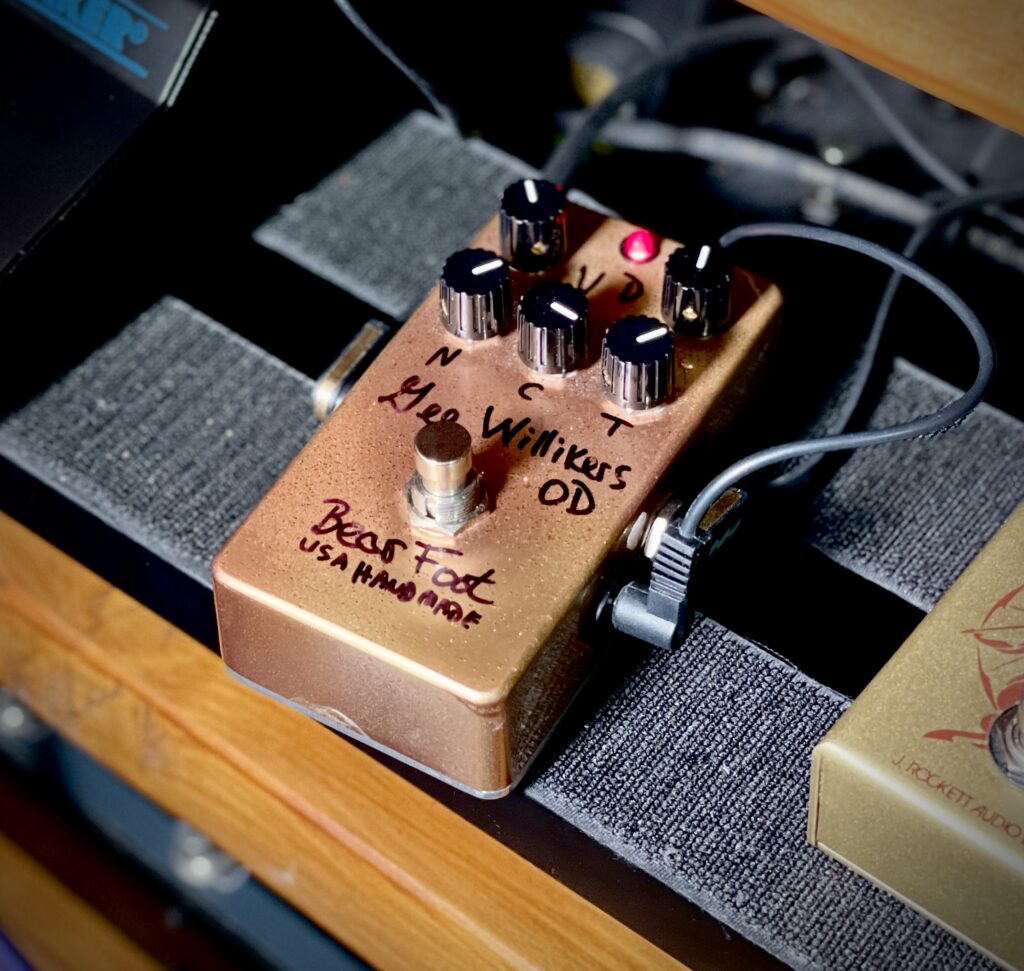I recently picked up another tweed tone pedal: the Gee Willikers (Model G) overdrive pedal from Bearfoot FX.

What do I think of it? Read on for my First Impressions.
Table of Contents
- What Did You Buy?
- Gee Willikers?
- Why Did You Buy This Pedal?
- What Do EQ The Controls Do?
- What Is Your Signal Chain?
- How Does It Sound?
- Does It Klon?
- Final Thoughts
What Did You Buy?
I bought a Gee Willikers (Model G) overdrive pedal, by Bearfoot FX. I got it from the second-hand market.
Gee Willikers?
Yeah, I had to google that. It’s old American slang, a way of expressing innocent wonder and delight … apparently 🤷♂️
I’m just going to call it the Model G throughout this blog post. It’s much easier to type!
Why Did You Buy This Pedal?
There’s a few reasons why:
- it’s based on a BJFe design, and he’s my all-time favourite pedal designer
- Bearfoot FX pedals are getting exceedingly rare these days
- it’s a tweed-tone 😍 pedal
It’s a 5-knob version of the classic Bearfoot FX Model G pedal.
The Model G is one of the rarely-discussed tweed-tone pedal designs from BJFe, and (as far as I can work out) seems to be derived from the legendary Honey Bee OD. The Model G has tweaks to chase the tone of Gibson’s 50s/60s guitar amps.
BJFe put out a 5-knob version of the Model G at some point in the past. I haven’t seen one myself. I’ve seen that version described as having a traditional Bass / Mids / Treble EQ control section (a bit like the Mad Professor Sweet Honey Overdrive Deluxe does). I’m getting this information from various internet forums, so who knows if it’s an accurate description 🤷♂️
The EQ controls on this Bearfoot FX pedal definitely ain’t that …
What Do EQ The Controls Do?
As far as I can discover, the three EQ controls are:
- ‘N’ is the ‘Nature’ control. It controls the low-end, and to my ears sounds similar to the ‘Focus’ control found on the Mad Professor Sweet Honey Overdrive.
- ‘C’ controls both upper-mids and compression. I think of this as the ‘Cut’ control.
- ‘T’ is a ‘Treble Trim’ control.
All three controls are somewhat interactive with each other, and with the Drive control.
I don’t think the controls are there to give you different sounds out of the pedal. I find that they’re best used to dial in the sound of the pedal for different guitars – something that’s common with most pedals I’ve tried that are based on a BJFe design.
That’s one of the many reasons why I love BJFe-designed pedals and their faithful derivatives.
Given the choice, I’d much rather have a pedal with just one sound and a flexible EQ section, so that I can make it work with whatever guitar I want. Then, it’s simply down to whether or not I like what the pedal is trying to do.
What Is Your Signal Chain?
My signal chain today is:
- my Fender Telecaster (known as Spot) or my Gibson Les Paul R9 (known as The 59)
- into the Axe-FX 3 (mostly for the tuner)
- out to my pedalboard
- back into the Axe-FX 3 (for amp, cab, digital delay and digital reverb)
- out to my audio interface
- and into Presonus Studio One
On the pedalboard, I have three pedals:
- The Model G
- The Bearfoot FX Uber Bee
- The Ceriatone Centura
All three pedals are in separate loops of my Gigrig G2. When a pedal isn’t being used, it’s completely out of the signal chain, so that it doesn’t affect the tone at all.
I’ve picked out the Uber Bee because the Model G is based on the BJFe Honey Bee circuit. I have a Honey Bee, but it’s the stock 3-knob version. The Uber Bee has 4 controls, and I think that makes it easier to dial in for the audio comparisons.
How Does It Sound?
I’ve recorded five audio demos for you, so that you can hear it for yourself.
Telecaster Neck Pickup
First up, this is what the Model G sounds like, using the neck pickup of my Fender Telecaster:
To my ears, that sounds very vintage, in a very delightful way. All the energy is in the upper-mids, and I’m finding the overdrive to be very thick and amp-like without losing detail. It also sounds like the top-end is nicely rounded off, which also adds to the amp-like characteristic.
For comparison, here’s the same guitar into the Bearfoot FX Uber Bee:
What I’m hearing is that the Uber Bee sounds more modern: there’s less push in the mids, a lot more low-end, and the top-end sounds like it extends into higher frequencies too. I’d go as far as saying that, compared to the Model G, the Uber Bee sounds more hi-fi.
Les Paul Middle Position
Next up, here’s what the Model G sounds like using the middle position of my Les Paul:
As far as I’m concerned, that right there is a great tweed tone. I think that’s one of the best tweed tones that I’ve been able to capture and share with you so far. It could do with a little more low-end, for sure; I’m confident I can dial that in as my experience with the pedal grows over time.
It wasn’t an easy tone to dial in, though. I ended up having to back off the bridge volume on my Les Paul to get the best out of the Model G.
For comparison, here’s what the Uber Bee sounds like with the same guitar:
This was a surprise. With the Les Paul, there’s a lot less difference between the two pedals. I can hear a difference in the low end – and the Uber Bee sounds a little more refined, somehow – but that’s about it.
I doubt that I could tell these pedals apart in a blind test. Maybe with fresh ears?
Does It Klon?
For the final audio demo: does the Model G sound great with a Klon in front of it?
To find out, I grabbed my Ceriatone Centura, set it up in the classic clean boost configuration, and placed it in my signal chain in front of the Model G:
The good news is that the Model G works with a Klon in front to fit. (I’ve had problems in the past doing this with the Uber Bee … something I need to retest one day.) So yay!
Final Thoughts
This pedal has given me a lot to think about.
When I first got it, I felt that I’m starting to hit the laws of diminishing returns now; that each new (to me) tweed tone pedal doesn’t have much new to offer. All these tweed-tone pedals are chasing the sound of a small number of amplifiers. Collect enough of them, and they’re going to overlap quite a lot.
As I started comparing it with some of my other tweed tone pedals, though, the more I started to appreciate this pedal. It’s got a raw, amp-like tone that I’m really falling for. I also love how the overdrive sounds. It makes so many other tweed tone pedals sound thin by comparison.
My two favourite tweed-tone pedals are my beloved Mad Professor Sweet Honey Overdrive (SHOD for short) and the PRS Horsemeat. The Model G is pushing its way into that list … along with another newcomer, which I’ll discuss in an upcoming blog post 🤫

One Reply to “First Impressions: Bearfoot FX Gee Willikers (Model G) Overdrive Pedal”